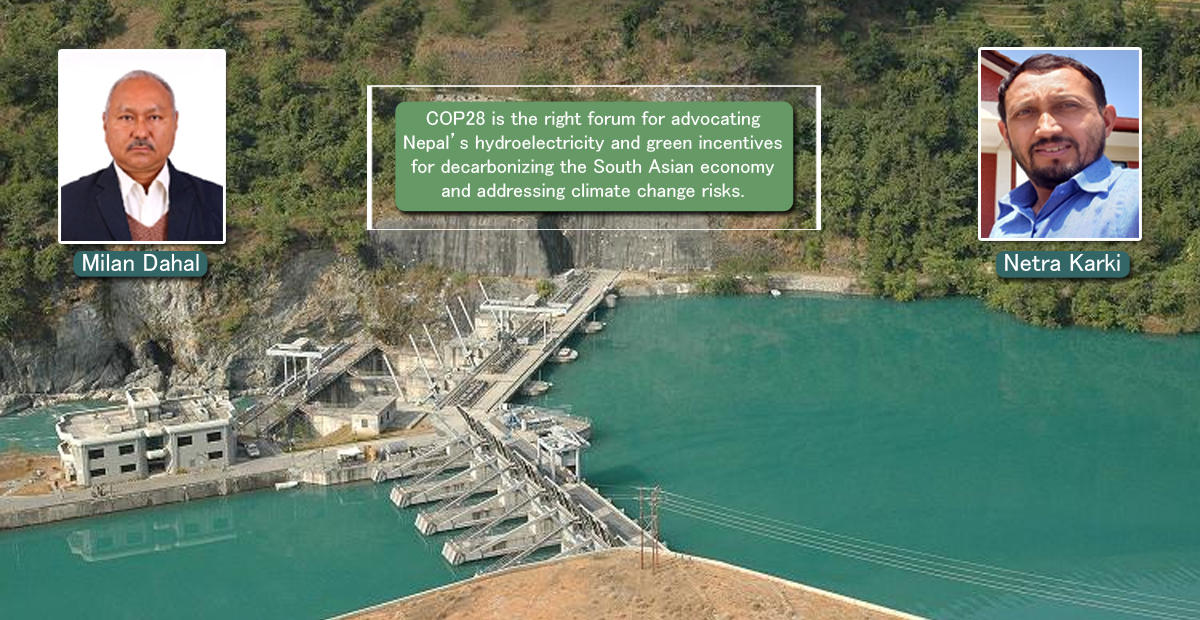
Abstract
Nepal possesses significant hydroelectric potential, with an economic capacity of 42,000 MW and a theoretical capacity of 83,000 MW. Though Nepal’s installed hydroelectric capacity is currently just little more than 2600 MW, Nepal is exporting its surplus energy to India and hopefully soon to Bangladesh. So, Nepal is ambitiously planning to develop hydroelectric projects in future. On other hand, Nepal’s hydroelectric sector is extremely vulnerable to climate change. By delivering clean and green energy, Nepal’s hydroelectricity may make substantial contribution to decarbonizing South Asian economy and achieve net-zero emission target. Therefore, Nepal's hydroelectricity should be supported by green incentives and integrated into cross-border power trade with neighboring countries.

Nepal’s Hydropower Scenario
Due to presence of more than 6,000 rivers flowing down from the Himalayas, Nepal possesses huge hydropower potential. Several studies have shown Nepal’s hydroelectric potential with an economic capacity of 42,000 megawatts and a theoretical capacity of 83,000 MW (H. Gunatilake et al., 2020). Nepal’s journey into hydroelectricity began over a century ago with the establishment of its first power plant in 1911, which had capacity of 500 kW.

Despite being dormant for decades, hydropower development in Nepal saw a significant shift in 1992 with the introduction of the Hydropower Development Policy, which allowed for private sector involvement. This policy change led to a rapid acceleration in hydropower development in the country.
The Nepal Electricity Authority (NEA) is a sole government organization responsible for the generation, transmission and distribution of Electricity within Nepal and cross-border. Nepal’s total electricity generation capacity reached 2,684 MW in August 2023 with majority coming from hydroelectric plants. Of this capacity, 1,477 MW is generated from hydroelectric projects owned by the private sector. (NEA, 2023)
In the year 2022/23 fiscal year, Nepal’s annual energy consumption per capita reached 380 units. The country is on track to provide access to electricity for the entire population within the next two years. Nepal is prioritizing increasing internal energy consumption through expanding industries, promoting electric vehicles, supporting agricultural growth with irrigation and encouraging the adoption of electric cooking.
Recently, the Ministry of Energy, Water Resources and Irrigation has developed an Energy Development Road Map and Action Plan with a focus on energy security and the clean energy transition. The plan aims to generate 28,713 megawatts of electricity by 2035, with a goal of exporting 15,000 MW to neighboring countries.
As of September 2023, Nepal has already awarded construction licenses for a total of 8792 MW to 238 different hydroelectric projects till September 2023. Additionally, the Department of Electricity Department (DoED) is currently processing applications for the construction of 109 hydroelectric projects with a total capacity of 11651 MW (DoED, 2023). Therefore, it seems realistic for Nepal to aim for 28,713 MW of hydroelectricity in the next 12 years despite numerous challenges that may arise.
Cross border Power Trade
Nepal is located between India and the People’s Republic of China (PRC), both of which are competing for the top position in the world economy. In Nepal's neighborhood, Bangladesh's economy is growing rapidly. All of these countries need a tremendous amount of electricity for their growing economies.
Though Nepal’s installed hydroelectric capacity is currently just little more than 2,600 MW, Nepal is exporting its surplus energy to India and hopefully soon to Bangladesh. During dry seasons, Nepal also imports electricity from India when the generation of hydropower plants decrease. Nepal is currently a net importer of electricity, but the situation is expected to change soon.
Nepal became the first country in South Asia to participate in Indian Energy Exchange (IEX). According to the Power Purchase Department of NEA, Nepal was exporting up to 632 MW of power from hydropower projects as of November 7th, 2023. However, cross-border power trade between Nepal and India is a tedious task from Nepal’s perspectives.
Firstly, there is a lack of cross-border transmission lines with sufficient capacity. Currently, there is only one high voltage transmission line (Dhalkebar-Muzaffarpur) between Nepal and India with a capacity of 1,000 MW and the next transmission line (New Butwal-Gorakhpur) with 2,000 MW is under progress. Nepal is encountering significant costs for the construction of these transmission lines, as well as substantial wheeling charge. Nepal has included cross-border transmission lines with China on its list, but it may not be a practical option.
Nepal’s next challenge in exporting hydroelectricity is obtaining approval for individual hydropower projects from the Designated Authority of India. In order to obtain approval from Indian authorities, detailed information about hydropower projects, including the identity of investors is necessary. The export approval for Nepal's hydroelectricity by India has been influenced by unfair geo-political interests and a desire for dominance over Nepal.
Furthermore, the power trade agreement between Nepal and India is only valid for a duration of one year and must be renewed annually. Nepal is currently only selling 110 MW as per the five-year agreement. Nepal is looking forward a long-term power trade agreement with India, which is essential for the future of hydropower development in Nepal. The current cross-border power trade between Nepal and India is not advantageous for Nepal. It should be a win-win situation for both of Nepal and India.
Selling hydroelectricity to the South Asian market is a Nepali dream for national prosperity. Nepal has the potential to use its hydroelectricity for producing green hydrogen fuel, but this opportunity has not yet been fully explored.
Risks of Climate Change
Nepal is sandwiched between China and India, the first and third biggest carbon polluters in the world (Climate Change News, 2021). Nepal is a country that has made minimal contributions to global warming but is among the most vulnerable countries to climate change. Nepal is experiencing rapid snow melt in the Himalayas, along with other impacts of climate change including decreased agricultural productivity, flash floods, and landslides (Basnyat, 2023).
Water is a raw material for hydroelectricity, as the generation of hydroelectricity depends on the availability of running surface water. The disturbance to the hydrological pattern due to climate change poses a significant risk to hydroelectric projects. Thus, Nepal’s hydroelectric sector is extremely vulnerable to climate change.
Hydroelectric projects, especially large dam projects, have significant environmental and social impacts. Utilizing Impact Assessment tools, as well as environmental monitoring and management, for hydroelectric projects can help to minimize their environmental and social impacts. In Nepal, hydroelectric projects are legally obligated to adopt environmentally friendly and socially accepted practices during the construction and operation of the project.
Green Incentives to Nepal’s hydroelectricity
Hydropower has received favorable consideration recently due to its potential to mitigate climate change. Moreover, this study shows that Nepal has potential to significantly contribute in providing environmental services to the South Asian region by delivering clean, renewable energy while mitigating climate change (H. Gunatilake et al., 2020).
Nepal’s hydroelectricity may make substantial contribution to decarbonizing South Asian economy and achieve net-zero emission target. The supply of hydroelectric power from Nepal to India and Bangladesh directly contributes to the shutdown of coal-fired electricity generating plants. The main issue of energy transition all over the world is replacing coal-fired plants. India is the second largest producer and consumer of coal after China (IEA, 2021).
Nepal’s hydroelectricity directly contributes to phasing-down fossil fuels and decarbonizing South Asian economy. In order to achieve the objectives of the 2015 Paris Agreement on climate change, it is imperative to promptly reduce emissions and achieve net-zero emissions by the middle of the century. India has delayed its net-zero emission target to 2070.
The Nationally Determined Contributions (NDC) report of India states that the country aims to achieve 50% of its energy consumption from renewables (non-fossil fuel-based energy resources) by 2030. This target is "Critically insufficient" when compared to the level of reductions needed in India to be consistent with limiting warming to 1.5°C. Substantial improvement is needed in this target and India will need international support to get onto a 1.5°C pathway (India Country Summary, 2023). India has set a target to install 500 GW of renewable energy capacity by 2030. Nepal's hydroelectricity can be a valuable supplement to India's goal of achieving 500 GW of renewable energy.
In this context, Nepal deserves climate justice from its neighboring countries, which are competing for top positions in the global economy. From an eco-nationalist viewpoint, Nepal justifies to claim green incentives for exporting hydroelectricity, which is produced at the risk of climate change and contributes to importer countries' efforts to decarbonize their economy and achieve net-zero targets. Green incentives to Nepal’s hydroelectricity should be integrated into the cross-border power trade. COP28 is the right forum for advocating Nepal’s hydroelectricity and green incentives for decarbonizing the South Asian economy and addressing climate change risks.
Dahal and Karki are associating with multiple sector as an energy expert for a long.
(Email: [email protected], [email protected])
